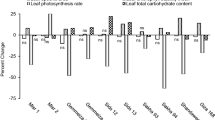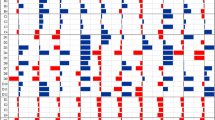Abstract
The effect of drought on barley leaf epicuticular wax load (EWL), residual transpiration rates (RTR) and grain yield was examined by subjecting 12 barley genotypes to controlled irrigation and terminal water stress conditions. The mean leaf epicuticular wax load was found to be 9% greater in the plants subjected to terminal water stress than in those provided irrigation, while the mean residual transpiration rate of the irrigated plants was 20% higher than in those subjected to water stress. Under these stress conditions, the correlation between grain yield and the epicuticular wax load was positive (P < 0.01), while that between the grain yield and the residual transpiration rate was negative (P < 0.05). Under the water stress conditions, the breeding lines studied showed a greater mean epicuticular wax load than the commercial varieties, while the residual transpiration rate was greater in these varieties than in the breeding lines. The greater epicuticular wax load of the breeding lines favoured their tolerance of drought, improving their yields over those of the commercial varieties.



Similar content being viewed by others
References
Araus JL, Febrero A, Vendrell P (1991) Epidermal conductance in different parts of durum wheat grown under Mediterranean conditions: the role of epicuticular waxes and stomata. Plant Cell Environ 14:545–558
Burow GB, Franks CD, Xin Z (2008) Genetic and physiological analysis of an irradiated bloomless mutant (epicuticular wax mutant) of sorghum. Crop Sci 48:41–48
Cameron KD, Teece MA, Smart LB (2006) Increased accumulation of cuticular wax and expression of lipid transfer protein in response to periodic drying events in leaves of tree tobacco. Plant Physiol 140:176–183
Cattivelli L, Rizza L, Badeck FW, Mazzucotelli E, Mastrangelo AM, Francia E, Marè C, Tondelli A, Stanca AM (2008) Drought tolerance improvement in crop plants: An integrated view from breeding to genomics. Field Crops Res 105:1–14
Clarcke JM, McCaig TN (1982) Excised-leaf water retention capability as an indicator of drought resistance of Triticum genotypes. Can J Plant Sci 62:571–578
Clarke JM, Richards RA (1988) The effects of glaucousness, epicuticular wax, leaf age, plant height, and growth environment on water loss rates of excised wheat leaves. Can J Plant Sci 68:975–982
Clarke JM, Townley-Smith TF (1986) Heritability and relationship to yield of excised-leaf water retention in durum wheat. Crop Sci 26:289–292
Clarke JM, Romagosa I, Jana S, Srivastava JP, McCaig TN (1989) Relationship of excised–leaf water loss rate and yield of durum wheat in diverse environments. Can J Plant Sci 69:1075–1081
De Vita P, Nicosia OLD, Nigro F, Platani C, Riefolo C, Di Fonzo N, Cattivelli L (2007) Breeding progress in morpho-physiological, agronomical and qualitative traits of durum wheat cultivars released in Italy during the 20th century. Eur J Agron 26:39–53
Ebercon A, Blum A, Jordan WR (1977) A rapid colorimetric method for epicuticular wax content of sorghum leaves. Crop Sci 17:179–180
Febrero A, Fernández S, Molina-Cano JL, Araus JL (1998) Yield, carbon isotope discrimination, canopy reflectance and cuticular conductance of barley isolines of differing glaucousness. J Exp Bot 49:1575–1581
González A, Martín I, Eyerbe L (2007) Response of barley genotypes to terminal soil moisture stress: phenology, growth, and yield. Aust J Agric Res 58:29–37
González A, Martín I, Eyerbe L (2008) Yield and osmotic adjustment capacity of barley under terminal water-stress conditions. J Agron Crop Sci 194:81–91
Haley SD, Quick JS, Morgan JA (1993) Excised-leaf water status evaluation and associations in field-grown winter wheat. Can J Plant Sci 73:55–63
Haussmann BIG, Obilana AB, Blum A, Ayiecho PO, Schippack W, Geiger HH (1998) Hybrid performance of sorghum and its relationship to morphological and physiological traits under variable drought stress in Kenya. Plant Breed 117:223–229
Jefferson PG, Johnson DA, Asay KH (1989) Epicuticular wax production, water status and leaf temperature in triticeae range grasses of contrasting visible glaucousness. Can J Plant Sci 69:513–519
Jenks MA, Ashworth EN (1999) Plant epicuticular waxes: function, production, and genetics. In: Janick J (ed) Hortic Rev 23:1–68
Jenks MA, Joly RJ, Peters PJ, Rich PJ, Axtell JD, Ashworth EN (1994) Chemically induced cuticle mutation affecting epidermal conductance to water vapor and disease susceptibility in sorghum bicolor L. Moench. Plant Physiol 105:1239–1245
Jetter R, Schaffer S, Riederer M (2000) Leaf cuticular waxes are arranged in chemically and mechanically distinct layers: evidence from prunus laurocerasus L. Plant Cell Environ 23:619–628
Jordan WR, Monk RL, Miller FR, Rosenow DT, Clark LE, Shouse PJ (1983) Environmental physiology of sorghum. I. Environmental and genetic control of epicuticular wax load. Crop Sci 23:552–558
Jordan WR, Shouse PJ, Blum A, Miller FR, Monk RL (1984) Environmental physiology of sorghum. II. Epicuticular wax load and cuticular transpiration. Crop Sci 24:1168–1173
Larsson S, Svenningsson M (1986) Cuticular transpiration and epicuticular lipids of primary leaves of barley (Hordeum vulgare). Physiol Plant 68:13–19
Malik TA, Wright D, Virk DS (1999) Inheritance of net photosynthesis and transpiration efficiency in spring wheat, Triticum aestivum L., under drought. Plant Breed 118:93–95
Masle J, Gilmore SR, Farquhar GD (2005) The ERECTA gene regulates plant transpiration efficiency in Arabidopsis. Nature 436:866–870
McCaig TN, Romagosa I (1989) Measurement and use of excised-leaf water status in wheat. Crop Sci 29:1140–1145
Merah O, Deléens E, Souyris I, Monneveux P (2000) Effect of glaucousness on carbon isotope discrimination and grain yield in durum wheat. J Agron Crop Sci 185:259–265
Morrison MJ, Voldeng HD, Cober ER (1999) Physiological changes from 58 years of genetic improvement of short-season soybean cultivars in Canada. Agron J 91:685–689
Nautiyal PC, Raigopal K, Zala PV, Pujari DS, Basu M, Dhadhal BA, Nandre BM (2008) Evaluation of wild Arachis species for abiotic stress tolerance: I. Thermal stress and leaf water relations. Euphytica 159:43–57
Nizam Uddin M, Marshall DR (1988) Variation in epicuticular wax content in wheat. Euphytica 38:3–9
Paje MM, Ludlow MM, Lawn RJ (1988) Variation among soybean (Glycine max (L.) Merr.) accessions in epidermal conductance of leaves. Aust J Agric Res 39:363–373
Premachandra GS, Saneoka H, Fugita K, Ogata S (1992) Leaf water relations, osmotic adjustment, cell membrane stability, epicuticular wax load and growth as affected by increasing water deficits in sorghum. J Exp Bot 43:1569–1576
Reynolds MP, Trethowan R, Crossa J, Vargas M, Sayre KD (2002) Physiological factors associated with genotype by environment interaction in wheat. Field Crops Res 75:139–160
Richards RA, Rawson HM, Johnson DA (1986) Glaucousness in wheat: Its development and effect on water-use efficiency, gas exchange and photosynthetic tissue temperatures. Aust J Plant Physiol 13:465–473
Richards RA, Rebetzke GJ, Condon AG, van Herwaarden AF (2002) Breeding opportunities for increasing the efficiency of water use and crop yield in temperate cereals. Crop Sci 42:111–121
Samdur MY, Manivel P, Jain VK, Chikani BM, Gor HK, Desai S, Misra JB (2003) Genotypic differences and water-deficit induced enhancement in epicuticular wax load in peanut. Crop Sci 43:1294–1299
Sánchez FJ, Manzanares M, de Andrés EF, Tenorio JL, Ayerbe L (2001) Residual transpiration rate, epicuticular wax load and leaf colour of pea plants in drought conditions. Influence on harvest index and canopy temperature. Eur J Agron 15:57–70
Steinmüller D, Tevini M (1985) Action of ultraviolet radiation (UV-B) upon cuticular waxes in some crop plants. Planta 164:557–564
Svenningsson M, Liljenberg C (1986) Changes in cuticular transpiration rate and cuticular lipids of oat (Avena sativa) seedlings induced by water stress. Physiol Plant 66:9–14
Teulat B, Rekika D, Nachit MM, Monneveux P (1997) Comparative osmotic adjustment in barley and tetraploid wheats. Plant Breed 116:519–523
Xue G-P, McIntyre CL, Chapman S, Bower NI, Way H, Reverter A, Carke B, Shorter R (2006) Differential gene expression of wheat progeny with contrasting levels of transpiration efficiency. Plant Mol Biol 61:863–881
Zadoks JC, Chang TT, Kozank CF (1974) A decimal code for the growth stages of cereals. Weed Res 14:415–421
Zhang JY, Broeckling CD, Sumner LW, Wang ZY (2007) Heterologous expression of two Medicago truncatula putative ERF transcription factor genes, WXP1 and WXP2, in Arabidopsis led to increased leaf wax accumulation and improved drought tolerance, but differential response in freezing tolerance. Plant Mol Biol 64:265–278
Author information
Authors and Affiliations
Corresponding author
Rights and permissions
About this article
Cite this article
González, A., Ayerbe, L. Effect of terminal water stress on leaf epicuticular wax load, residual transpiration and grain yield in barley. Euphytica 172, 341–349 (2010). https://doi.org/10.1007/s10681-009-0027-0
Received:
Accepted:
Published:
Issue Date:
DOI: https://doi.org/10.1007/s10681-009-0027-0




